3.8 The Project Development Presentation
The Project Manager should now have a completed project waiting to be tested , a completed first-draft document, and a complete Beta Plan. If it has been over six months since the Project Concept Plan was presented, Business Development needs to update the Project Requirements Document and update the executive staff with any changes. The Project Manager can now present to the executive staff any changes from the Phase 2 review and present the features and functionality that were developed. Additionally, the Project Manager confirms that the market positioning is updated, that the costs are accurate, and that the schedule is on track, as well as annotates any changes to the schedule presented in Phase 2. The Project Manager updates and presents any changes to the Baseline Cost Document presented in Phase 2. (See Figure 3.2.)
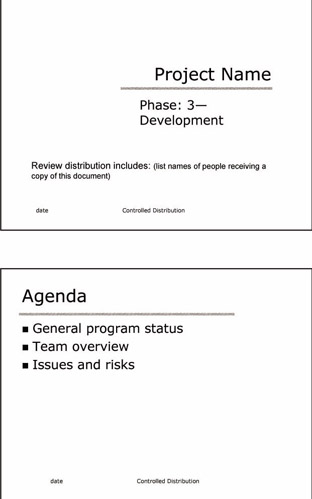
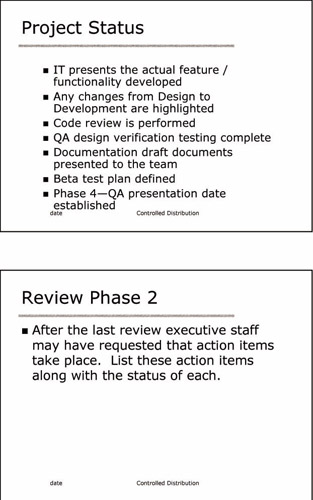



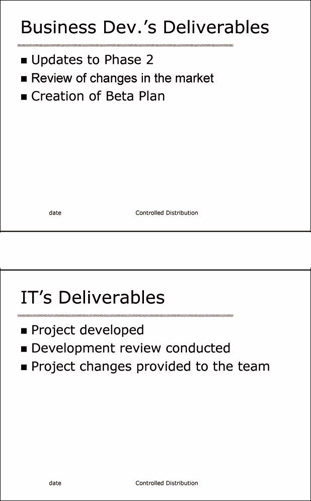
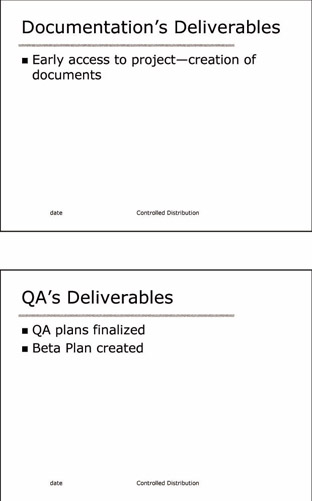
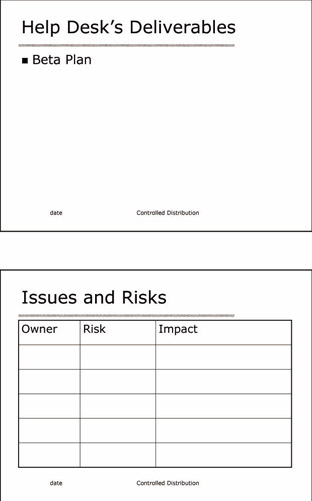
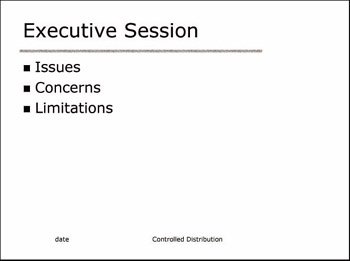
Figure 3.2: Project Development Presentation
Page 1: Cover Page. This document is for controlled distribution and lists the names of all the people attending and receiving the review handout. The cover page should have the project name , the phase, and the date.
Page 2: Agenda. List major items, the team members who will be presenting, and the time allotted for the presentations. Agenda items for a Phase 3 review may include introduction, general program status, team overview, and issues and risks.
Page 3: Phase 3 ”Project Development, Project Status. Review the items that have been created or completed in Phase 3 ”Project Development:
-
IT presents the actual feature/functionality developed
-
Any changes from Design to Development are highlighted
-
Code review is performed
-
QA design verification testing is complete
-
Documentation provides draft manuals and help files
-
Beta test plan defined
-
Phase 4 ”QA presentation date established
Page 4: Review Phase 2. After the last review, executive staff may have requested that action items take place. List these action items along with the status of each.
Page 5: Contract Summary. If contracts were signed for hardware, software, support services, or networking equipment, the estimated costs versus the actual costs should be listed along with any pertinent legal obligations.
Page 6: Integrated Schedule. List the start and completion date for the current phase and the previous phase of the following items: Development, Documentation, QA, Beta, Release, Maintenance.
Page 7: Updated Development Costs. List the following items by employee weeks and capital costs for the current phase and the previous phase ”Business Development, IT, QA, Documentation, Help Desk, Training, Communication.
Page 8: Contracted Costs. Previously these costs were estimated for hardware, software, services, staging/ fulfillment, and maintenance.
Page 9: Team Members. List all the members of the team and the functional areas they represent.
Page 10: Project Manager. List the deliverables the Project Manager created: for example, identify vendors for the project, execute strategic agreements, update financials and integrated schedule, create Beta Plan.
Page 11: Business Development. List the deliverables Business Development created: for example, updates to Phase 2, review of changes in the market, creation of Beta Plan.
Page 12: IT. List the deliverables created by IT: for example, project developed, development review conducted , project changes provided to the team.
Page 13: Documentation. List the deliverables created by Documentation: for example, Early access to project ”creation of documents.
Page 14: QA. List the deliverables by QA: for example, QA plans finalized, Beta Plan created.
148
Page 15: Help Desk . List the deliverables Help Desk created: for example, work with other departments to create the Beta Plan.
Page 16: Issues and Risks. For this phase, list issue, owner, risk, impact, and status.
Page 17: Executive Session. Executive sign-off ” executives note any action items for the team and agree to let the program move to the next phase.
3.8 in a Nutshell
At the end of Phase 3 ”Project Development, the team will need to present their accomplishments and changes to executive staff.
-
Any changes to the schedule and cost of the project
-
Any changes to the features of the project
-
Readiness for beta
EAN: N/A
Pages: 105